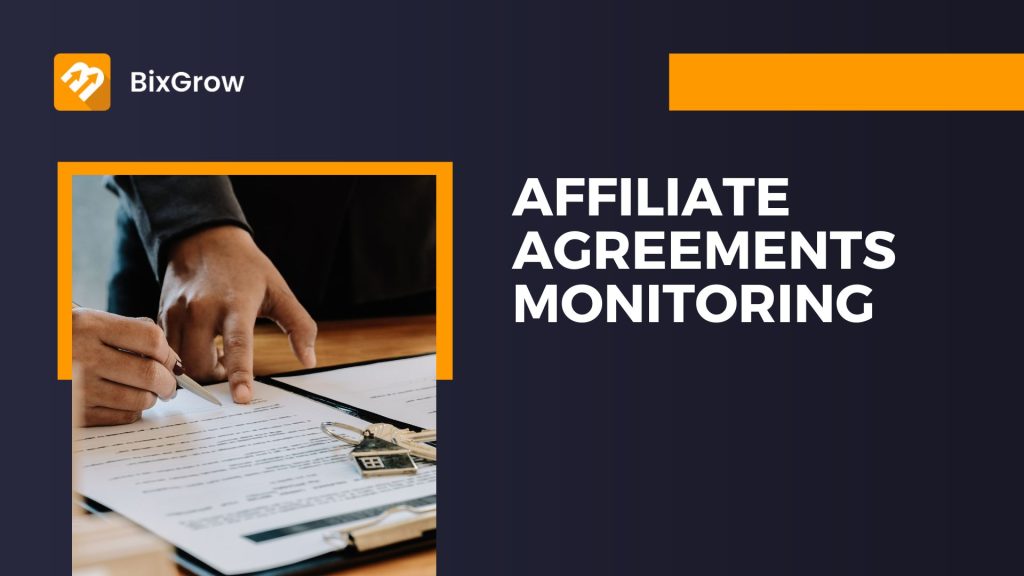Affiliate agreements are establishing clear terms between brands and their partners. However, not all the times do affiliates follow the contract. Hence, affiliate manager need to conduct Affiliate Agreement Monitoring continuously.
Let’s deep dive into the key aspects you should monitor in affiliate agreements, the tools available, and the best practices for keeping everything on track.

1. What are affiliate agreements monitoring?
Affiliate agreement monitoring tracks if affiliates follow contract rules with a brand. It checks key terms like payment plans, promotion guidelines, and intellectual property use. This ensures everyone sticks to the rules, creating a clear and fair partnership.
Monitoring affiliate agreements also includes verifying that affiliates follow the established rules for advertising and lead generation, as well as ensuring they don’t engage in fraudulent activities. In essence, it is about maintaining a clear and transparent relationship between both parties to avoid misunderstandings and legal complications.
For brands, affiliate agreement monitoring is crucial for protecting their business interests. By ensuring affiliates follow the agreed-upon guidelines and policies, brands can prevent issues such as fraudulent activities, misrepresentation, or misuse of intellectual property, which can damage their reputation or result in legal action. Monitoring helps brands maintain the integrity of their affiliate program and fosters a trustworthy environment for affiliates to thrive.
For affiliates, monitoring helps ensure that they are compensated correctly and fairly for their efforts. If a brand fails to adhere to the payment terms or does not properly track affiliate referrals, it could lead to disputes or a loss of trust. Monitoring also benefits affiliates by providing them with a clear understanding of the expectations, protecting their earnings, and ensuring that the brand follows through on agreed terms.
Therefore, regular monitoring of affiliate agreements is essential for building a long-term, positive partnership, ensuring both the brand and the affiliates can succeed together.
2. Key aspects to monitor in an affiliate program agreement?
For better affiliate policy monitoring, it’s crucial to focus on several key aspects that ensure the program runs smoothly, transparently, and fairly for all parties involved.
Here are the main components to keep an eye on:
2.1. Commission rates

Commission rates define the percentage or fixed amount an affiliate earns for each sale or lead generated through their referral links. In some case, commission rate may change regularly. Any changes in the rates should be communicated clearly and agreed upon by both parties to maintain trust and avoid dispute
- Is the commission rate aligns with what was agreed upon in the contract?
- What is the standard commission rate offered to affiliates, and does it vary based on product categories or performance tiers?
- How frequently are commission rates reviewed or adjusted?
- What protections are in place to prevent commission disputes, such as tracking issues or order cancellations?
2.2. Payment terms
Payment terms outline how and when affiliates are compensated for their sales or leads. This includes details on payout schedules, payment methods, and minimum payout thresholds. Timely and accurate payments are essential to maintain affiliate satisfaction and trust. Monitoring payment terms ensures affiliates receive their due compensation and that the agreed-upon payment methods and schedules are followed.
You should regularly review the payment schedule to ensure payments are made according to the terms, and confirm that no payment issues arise.

2.3. Promotional guidelines
These are the rules and restrictions placed on affiliates regarding how they can promote the products or services, such as approved ad formats, keywords, platforms, and messaging. To preserve the brand’s integrity and ensure that affiliates adhere to ethical marketing practices, it’s essential to monitor whether affiliates are following these guidelines.
- What is the payment schedule for affiliates (e.g., monthly, bi-weekly), and when exactly are payments processed?
- What are the minimum payout thresholds, and what happens if an affiliate doesn’t meet them in a payment cycle?
- Which payment methods do you support (e.g., bank transfer, PayPal), and are there any associated fees for affiliates?
- How do you handle payment delays or disputes, and what is the process for affiliates to report issues?
- Are there any conditions or hold periods (e.g., for refunds or chargebacks) before commissions are paid out?
Review the content affiliates publish, monitor their ads, and ensure that their marketing tactics align with the brand’s image and values.
2.4. Intellectual property use

Intellectual property use refers to how affiliates can use the brand’s logos, trademarks, and other protected assets in their marketing efforts. To protect the brand from legal risks and unauthorized use of its intellectual property, monitoring ensures that affiliates are using the brand assets correctly and within the scope of the agreement.
- What specific guidelines do affiliates need to follow when using your brand’s logos, trademarks, or marketing materials?
- Are there any restricted uses of your marketing assets (e.g., altering logos, using them in unapproved contexts) that affiliates should avoid?
- Do affiliates need prior approval before creating content that incorporates your intellectual property?
- What are the consequences for misuse?
- Are there provided assets (e.g., banners, images, or text) that affiliates can use, or do they need to create their own while adhering to your IP rules?
Confirm that affiliates are using brand assets (logos, images, etc.) following the rules laid out in the contract, ensuring no unauthorized modifications or uses.
2.5. Fraud prevention
Fraud prevention involves monitoring affiliates to ensure that no fraudulent activities, such as self-referrals, click fraud, or generating fake leads, are occurring. Fraudulent actions can damage the affiliate program’s integrity and result in financial losses. Preventing fraud is vital to ensure that only legitimate sales and leads are counted and that affiliates earn commissions fairly.
- Did you provide clear guidelines or training on acceptable practices?
- What measures/tools do you have in place to detect and prevent fraudulent activities?
- How do you verify the legitimacy of traffic and conversions generated by affiliates before approving commissions?
- Are there specific tools or technologies (e.g., fraud detection software) you use to monitor affiliate activity?
- What actions do you take if an affiliate is found engaging in fraudulent behavior? (Inactivate affiliate, inform emails?)
Regularly track referral activities and monitor affiliate performance for signs of fraudulent behavior, such as unusually high referral volumes or suspicious patterns.
3. Efficient ways to monitor affiliate program contracts
Affiliate program monitoring involves consistently reviewing and enforcing the guidelines and terms of the affiliate program to ensure compliance with the contract and maintain the integrity of the program. It helps ensure that both brands and affiliates understand their roles and responsibilities, which reduces conflicts and promotes transparency.
Here are the key components of affiliate policy monitoring:
3.1. Check compliance
Checking compliance means ensuring that affiliates follow the program’s terms and conditions, including adhering to promotional guidelines, intellectual property rules, and the agreed-upon commission structure. Non-compliance can lead to disputes, fraud, and damage to the brand’s reputation. Monitoring compliance helps maintain a smooth and professional affiliate program.
What to monitor: Review affiliate activities, including advertising tactics and promotional content, to ensure alignment with the terms of the agreement. Any deviation should be addressed promptly.
3.2. Review content
Regularly review the content produced by affiliates (blogs, social media posts, ads, etc.) to ensure it aligns with the brand’s guidelines and legal requirements. Affiliates may unintentionally promote products or services in a way that is misleading, unethical, or in violation of the brand’s guidelines. Regular content reviews ensure that affiliates’ promotional efforts reflect the brand’s values.
What to monitor: Check for consistency in messaging, the use of trademarks or brand assets, and ensure no false claims or misleading information is used. Review the channels on which the affiliate is promoting (social media, websites, etc.).
3.3. Track performance
Monitoring the performance of affiliates to ensure they are delivering the expected results in terms of leads, sales, and traffic. Tracking affiliate performance ensures that your program is efficient and that affiliates are working towards the brand’s goals. Poor performance can indicate non-compliance or fraudulent activities.
What to monitor: Regularly track metrics like click-through rates, conversion rates, and sales volumes. This helps identify which affiliates are underperforming or potentially engaging in fraudulent activity.
3.4. Update terms
Keeping the affiliate agreement and policies up-to-date to reflect any changes in business practices, legal requirements, or market conditions. As markets evolve, new laws and regulations are introduced, and business practices change, making it essential to update terms regularly to protect the brand and its affiliates.
What to monitor: Ensure that affiliate agreements reflect current compliance with laws such as GDPR or CCPA and that any necessary changes in commission structures, payment terms, or promotional strategies are addressed.
3.5. Use tools
Using affiliate program management tools to automate and simplify monitoring tasks. Tools can help streamline the monitoring process, enabling brands to manage large affiliate programs with ease. They provide real-time tracking, performance metrics, and alerts for potential violations.
What to monitor: Utilize reporting tools to track affiliate performance, ensure compliance, and generate detailed reports that highlight any areas of concern. Popular tools like BixGrow, CJ Affiliate, and Impact Radius help with tracking and monitoring.
3.6. Regular audits
Conducting audits of affiliate activities at regular intervals. Audits ensure that affiliates are adhering to the terms and conditions outlined in the contract. They help identify any discrepancies or potential violations early on, preventing issues from escalating.
You should perform periodic checks on affiliate performance, promotional content, and payment tracking. Using affiliate management software can automate much of this process.
3.7. Automated tracking and reporting
What it is: Utilizing automated tools to track affiliate performance and compliance with the contract in real time. Automation reduces human error and ensures you have access to up-to-date data. It also helps save time by automating repetitive monitoring tasks.
Use affiliate management platforms like BixGrow, Refersion, or Tapfiliate, which offer automated tracking for clicks, sales, and commissions. They can provide real-time reports, and performance metrics, and alert you to any irregularities.
3.8. Regular communication with affiliates
Maintaining open lines of communication with affiliates to discuss their performance, address concerns, and remind them of contract terms. Communication helps build trust and prevents misunderstandings between you and your affiliates. It’s also a great way to stay updated on any changes or challenges affiliates may be facing.
Schedule monthly or quarterly check-ins, send reminders about contract updates, and ask for feedback about their experiences with the program.
3.9. Set clear performance metrics
Defining specific performance metrics that affiliates must meet, such as sales, leads, or traffic volume. Having clear metrics makes it easier to track affiliate performance objectively. It also helps you identify affiliates who may not be pulling their weight or violating contract terms.
Establish realistic, measurable goals for affiliates, and track them using affiliate program management tools. Metrics should include KPIs like conversion rates, sales numbers, and click-through rates.
3.10. Investigate any signs of fraud
Regularly monitoring for fraudulent activities, such as self-referrals, click fraud, or fake leads. Fraudulent activities can harm your affiliate program’s integrity and lead to financial loss. Detecting fraud early can prevent long-term damage to your brand.
Use fraud detection tools that flag suspicious activities like unusually high conversion rates or duplicate IP addresses. Investigating any red flags and taking corrective action when necessary is crucial in affiliate rules monitoring.
4. Signs of affiliate fraud & infringements
Affiliate fraud and infringements can cause significant damage to your affiliate program. Understanding how to identify these issues early can help prevent financial loss and protect the integrity of your program.
4.1. Unusually high or rapid sales
An unexpected spike in sales or leads from a specific affiliate, especially if the affiliate’s marketing methods don’t seem aligned with the increase in performance. High or rapid sales numbers can indicate fraud, such as self-referrals or fake leads, where affiliates are generating sales through their own efforts to earn commissions.
You should compare the affiliate’s performance to historical data and industry benchmarks. Cross-check transactions against legitimate customer data to verify authenticity.
4.2. Duplicate IP addresses or geographical irregularities
Multiple sales or leads originate from the same IP address or geographically unusual locations, especially when they come from affiliates who are not targeting those regions.
This could be a sign of self-referrals or click fraud, where affiliates artificially inflate their numbers to earn more commission.
Use affiliate management software with fraud detection capabilities to track IP addresses and flag any suspicious activity. Set geographical restrictions if necessary.
4.3. Lack of transparency in promotional methods
Affiliates who are unclear about how they’re driving traffic or generating sales, or those who use promotional tactics not aligned with your brand’s values. Unethical marketing methods, such as spamming or using misleading ads, can damage your brand’s reputation and violate your affiliate agreement.
Regularly review the content affiliates post and ensure that it aligns with your brand guidelines. Communicate expectations clearly and require affiliates to submit reports on how they’re promoting your products.
4.4. False claims or misleading ads
Affiliates make false or exaggerated claims about your product, often in an attempt to boost conversions quickly. Misleading ads can cause customer dissatisfaction, damage your brand’s credibility, and lead to potential legal issues.
Monitor all affiliate ads for compliance with your guidelines. Request transparency from affiliates about the ads they’re running, and take corrective action if necessary.
4.5 Fake traffic or clicks
Affiliates use methods like bots, click farms, or paid traffic from unverified sources to generate fake clicks and inflate their commission earnings. This type of activity can severely impact the accuracy of your affiliate program’s performance data and lead to fraudulent claims for commission.
Use click fraud detection tools and monitor your affiliate traffic sources. Set up analytics to flag any abnormal spikes or patterns in traffic.
4.6. Non-compliance with contract terms
Affiliates who consistently fail to follow the agreed-upon terms and conditions, such as violating intellectual property guidelines or using prohibited marketing channels. Failure to adhere to contract terms can create legal liabilities, damage brand reputation, and disrupt the affiliate program.
Regularly review affiliates’ activities, track their performance against the terms of the contract, and issue warnings or penalties for non-compliance. If necessary, terminate relationships with affiliates who repeatedly violate the agreement to ensure affiliate contract compliance.
By staying vigilant and proactive in detecting affiliate fraud and infringements, you can ensure the long-term success of your affiliate program and protect both your brand and affiliates.
5. Tools for monitoring affiliate agreements
Effective affiliate agreement monitoring requires the right tools to track, analyze, and manage affiliate activity. Here are some of the most widely used tools for affiliate monitoring and why they’re beneficial for brands and affiliate managers:
Affiliate management platforms
These platforms allow brands to manage affiliate partnerships, track sales and commissions, and monitor affiliate performance in real time.
For example, BixGrow offers advanced automation features such as automatic affiliate approval and commission management, making it a great tool for scaling affiliate programs quickly. It also provides anti-frauds mode that can detect unusual traffics and affiliate activities.
Some platforms are ShareASale, Post Affiliate Pro,…
Key features:
- Centralized management of all affiliates
- Real-time tracking of affiliate actions and commissions
- Detailed reporting and performance analytics
- Fraud detection and prevention tools
- Customizable payout structures and commission rates
Fraud prevention and detection software
Specialized tools designed to detect fraudulent activity, such as click fraud, self-referrals, and the use of bots or fake leads.
Examples: ClickCease, Fraud Protection by Impact, and Forter.
Key features:
- Identification of suspicious clicks or sales
- Protection against fraud by monitoring IP addresses, geolocations, and device fingerprints
- Automated alerts when suspicious behavior is detected
- Integration with affiliate platforms to block fraudsters and prevent future issues
Performance analytics and reporting tools
Tools that provide in-depth analysis of affiliate performance, such as traffic sources, conversion rates, and ROI.
Examples: Google Analytics, MonsterInsights, or affiliate networks’ built-in analytics tools.
Key features:
- Tracking of affiliate-driven traffic and conversion data
- Customizable dashboards for monitoring key performance metrics (KPIs)
- Insights into what marketing tactics are working and which need improvement
- Identification of top-performing affiliates and opportunities for growth
Contract and legal monitoring tools
Tools that help brands manage affiliate contracts, ensuring affiliates are adhering to the agreed-upon terms and conditions.
Examples: DocuSign for contract management, PandaDoc, and HelloSign.
Key features:
- E-signatures for quick contract execution and updates
- Centralized storage of contracts and agreements for easy access and review
- Tools to track contract renewals, amendments, or termination conditions
- Legal templates for affiliate agreements to ensure compliance with laws and industry regulations
Conclusion
Affiliate agreements monitoring is a critical component of any successful affiliate program. By carefully tracking key aspects such as commission rates, payment terms, promotional guidelines, and intellectual property use, both brands and affiliates can build a mutually beneficial, transparent, and legally sound partnership. Detecting and preventing fraud or infringements early ensures that your program maintains integrity and prevents unnecessary financial losses or legal issues.
By maintaining a proactive approach to affiliate agreements monitoring and addressing issues promptly, businesses can foster long-term, successful affiliate relationships that contribute to growth and profitability. Stay vigilant, and your affiliate program will thrive with transparency, trust, and mutual benefit.